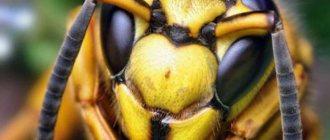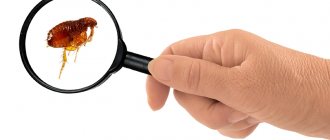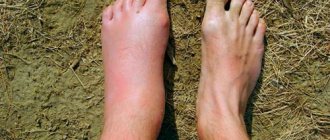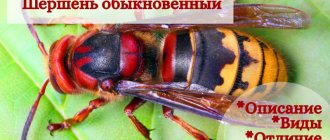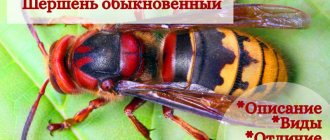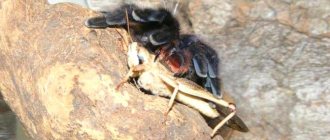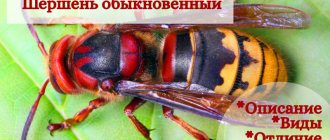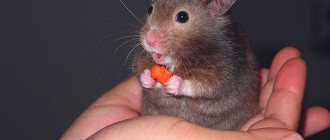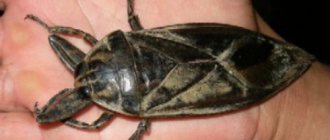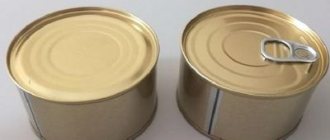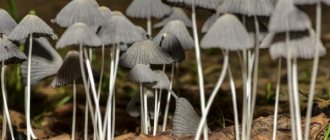Hornets belong to the wasp family. They are quite large, unlike their relatives, and have a sting of 3-6 mm. These insects can bring both benefit and harm to people.
So are hornets dangerous for humans and how to avoid their bites? The penetration of insect venom into the victim’s body causes an immune response, manifested by redness, swelling, pain, and itching.
With individual sensitivity, anaphylactic shock and death are possible. More often, serious complications are observed when bitten by tropical representatives, therefore, before traveling to such countries, it is necessary to carry out routine vaccination to strengthen the immune system.
Why is the hornet dangerous for humans?
Knowing how dangerous an ordinary hornet is for humans, you can imagine what consequences await the victim after a bite. The parasite's venom instantly activates an allergic reaction due to the presence of histamine in it. The degree of danger may vary and depends on the individual characteristics of the organism.
The minimal complication will be inflammation and swelling in the penetration area . With a strong immune response, an increase in body temperature, shortness of breath, significant swelling and inflammation of tissues, and anaphylactic shock are observed.
If a person is vaccinated with special vaccines, the body will more easily accept the poison and the negative consequences will be minimal. But this does not apply to cases of mass attacks by dangerous insects. With multiple hornet stings, the risk of death is very high.
In general, these insects are considered the most dangerous representatives of this subclass. You especially need to be wary of tropical pests that have deadly poison.
Although an ordinary hornet, when bitten by very sensitive individuals, can cause anaphylactic shock, followed by death.
Features of reproduction
The largest hornet reproduces in several stages, namely:
- The insect family lives for only one year.
- After the home grows, the number of worker representatives also increases, which is why the queen lays eggs again, thereby helping to create new individuals for future reproduction.
- Upon reaching maturity, the mating process begins, after which the males die, and the queens move to a quiet place, waiting for spring. With the arrival of the warm season, the possibility of creating new colonies arises.
- If it starts to rain, the old members of the family die.
The effect of hornet venom on the human body
Having figured out how hornets are useful, it is important to study the ability of the poison to act on the body in order to understand how to save the victim after a dangerous bite. First, a person feels a sharp throbbing pain, this is due to the presence of acetylcholine. It activates nerve endings even before significant tissue disorders and changes occur.
After a few seconds, the penetration site begins to swell . Swelling and inflammation can spread quickly, with damage to nearby tissues causing the bite site to greatly increase in size. Small blood vessels may fail and their rupture is visualized by small hemorrhages. In severe cases, hematomas and suppuration are observed.
The venom of these insects can release a toxin that causes dizziness, headaches, general intoxication, fever and increased heart rate. One bite rarely causes death, but in case of individual intolerance, anaphylactic shock may occur, and with late treatment, tissue necrosis.
Understanding how dangerous a hornet is for humans, it is worthwhile to reduce the risk of death at the first sign of an insect bite by providing assistance to the victim. This will not only save his life, but also reduce the number of unpleasant symptoms.
Lifestyle
Hornets build their nests everywhere: in hollow trees, in empty birdhouses and beehives, and also under the roofs of buildings. Families living in the steppe settle in the soil and in animal burrows. The nests of these insects are very similar to the homes of other types of wasps, the only differences are in color - in hornets they are brown, and in other wasps they are gray. Nests come in different sizes, but usually consist of 5-7 honeycombs with 500 cells each.
Working individuals and males are of the same age; in winter they all die. Only the queens remain for the winter; they remain in a state of hibernation until mid-May. When the air temperature reaches 10 °C, the fertile female wakes up and begins to build a nest for a new family.
Hornets are dangerous predators. Most of their diet consists of flies, gadflies, horseflies, small wasps and bees. The latter suffer most from hornets in the fall. During invasions, predators attack entire hives of bees, eating tens and hundreds of individuals per day. Fortunately for beekeepers, hornets feast mainly on sick and weakened individuals. In addition to insects, they love nectar, plant juices, berries and fruits.
If there is a lot of food, the hornet family grows quickly. This leads to the fact that all the insects do not fit in the nest. Therefore, we have to divide into small families that begin to exist independently.
How hornets attack
Hornets show particular aggression when defending their home. At first, one hornet may attack, but soon a whole swarm flocks to the smell of the signal aroma released during an attack. At the same time, wasps sting everyone who is closer, even if they do not take part in the destruction of the nest. The European representative of the species has a sting of 3 mm, while the more dangerous Asian one has a sting of 6 mm.
The aggressiveness of the insect is quite controversial . If you don’t touch him, don’t stir up the nest or accidentally crush him, then he attacks extremely rarely. If there is danger, the hornet first of all tries to hide, but if this is impossible, then it takes a defensive position. Smaller specimens sting more often; their larger counterparts are peaceful.
Description and types
Appearance
Hornet (Vespa) is a stinging insect of the order Hymenoptera and the largest representative of the genus of social wasps.
As an insect representing its family, the hornet has a wasp-like waist, striped abdomen, thin transparent wings, large eyes and powerful jaws. However, the hornet has a number of features by which it can be easily distinguished from the well-known wasp. He is twice the size of his relative. The hornet's coloration includes yellow, orange, brown and black, while the wasp's coloration is only yellow and black. The hornet is often called the largest wasp.
Varieties
The main distribution areas of the insect are the northern hemisphere of the planet up to the 63rd parallel. There are a total of 23 known species of hornets. They have many similarities: lifestyle, reproduction, dietary preferences, but they differ in external characteristics and sizes. The most common ones are:
- The common hornet (Vespa crabro) is the most famous species of insect that lives in the European part of Russia, the Urals, Siberia, Ukraine, Europe and eastern China. In the 19th century, the hornet accidentally arrived in North America and quickly spread there. The average size of a working hornet is from 18 to 22 mm, the uterus of a hornet is from 25 to 35 mm;
- The oriental hornet (Vespa orientalis) is the most beautiful of all hornet species. It has a bright red-brown color, and its abdomen is decorated with a clearly defined wide yellow stripe. This is the only hornet species that is resistant to the dry climate of steppes and deserts. It lives in southern Europe and Russia, Asia, northern Africa, and Madagascar. Female eastern hornets are 25–30 cm in size, the rest of the family are smaller;
- The Asian giant hornet (Vespa mandarinia) is the largest species of the entire wasp family and has several subspecies. It differs from other types of hornets by its yellow head and wide black stripes on its abdomen. It can reach a length of 5 cm, and its wingspan is 6-7 cm. The Asian hornet lives in China, Japan, Korea, India, the mountains of Sri Lanka and the Primorsky Territory of Russia. The Japanese subspecies of the giant hornet has acquired the name “sparrow-bee” due to its impressive size. In China it is called the tiger bee. This is the most dangerous type of hornet. The highly toxic venom of its sting is deadly to humans;
- The black hornet, otherwise known as Dybowski's hornet (Vespa dybowskii) is a rare and small species. It can be easily recognized by its completely black belly and brownish wings. Its dimensions are the same as those of an ordinary hornet. Lives in Japan, Korea, China, Thailand, India. In Russia it can be found in Transbaikalia, Primorye and the Amur region. The black hornet is a nest parasite. His female does not raise a family. She kills the queen of a colony of hornets of another species and becomes the head of the family in her place.
What to do if bitten by a hornet
When poison enters the muscle layer, the immune system is activated and a biological reaction to the damage occurs. Everything can be limited to swelling, redness, pain, itching, and temperature. If the patient’s body weight is low or the symptoms of intoxication are severe, it is important to quickly transport the victim to the hospital.
A bite into a large vessel is rarely observed, but this condition is extremely dangerous, since the hornet’s venom destroys the walls of the bloodstream. In this case, toxins will quickly attack the entire body and in a minimal period will reach the brain, causing a stroke. Such a patient can be saved if taken to the hospital in time.
First aid for a bite
No benefit from hornets can cover the harm they cause to humans. Since some people have an individual intolerance to insect venom, when bitten you need to act quickly and consistently.
- First you need to remove the poison and sting particles by squeezing them out.
- Then the wound is washed with soapy water, alcohol, and potassium permanganate.
- The patient is given an antihistamine. If the bite is in the neck, the oral cavity, or severe swelling of the mucous membranes makes swallowing difficult, then you need to inject an antidote.
- If you have a fever, drink antipyretic and plenty of fluids.
- If the patient is bothered by pain, then it is necessary to take an anesthetic drug.
- To reduce the risk of poison spreading throughout the body, apply cold and moistened sugar to the treated wound.
- If you have difficulty breathing, you need to open all windows and unfasten constricting clothing, remove collars and jewelry. When the condition improves, the patient is offered warm tea and a blanket.
- When signs of anaphylactic shock appear, while waiting for an ambulance, the patient is placed on a hard surface and care is taken to ensure that the patient’s tongue does not stick and there is access to oxygen.
Aspirin is strictly contraindicated in patients, as it thins the blood and can cause complications of the condition.
Health care
After the hornet attack and first aid, swelling and irritation are eliminated with creams based on lidocaine and hydrocartisone: Levomekol, Hydrocortisone ointment, Advantan, Akriderm. Antihistamines you can take are Fenistil, Suprastin, Tavegil. This will help reduce allergic symptoms. If the pressure drops, the patient is given Cordiamine.
From a home medicine cabinet to relieve the condition they use:
- Soda. Dip a wet finger in baking soda and rub the affected area until the desired area is completely covered.
- Juice of lemon, dandelion, plantain. Apply to the affected area to eliminate itching and swelling.
- Apple and onion slices. They are placed on the bite area until the condition is relieved.
Nutrition
The giant, fat Japanese representative consumes many foods and is considered an unpretentious species. Among the delicacies are sweets, including fruits, berries, and honey. It is also worth noting that their diet includes other insects - flies, butterflies, locusts, bees, and other representatives. They will not disdain eggs from which insects emerge.
Hornets are distinguished by the presence of powerful jaws, thanks to which they kill their victims. Next, they process it through saliva, chew it and take it to their own family. Adults do not consume insects, but only prey on them. Eating meat, fish and other animal food is characteristic only of larvae. To get food, hornets practically do not use a sting.
How to avoid a hornet sting
If an insect attacks, it is quite difficult to avoid a bite, which is why you need to take measures to prevent this situation,
for this:
- If you see an insect near a nest, you should quickly move as far as possible from the dangerous place.
- Do not touch or stir up the masonry even if there is no visible danger.
- When picking fruits, you need to carefully select the fruits, making sure that they are free of insects. If you bite the affected product, you can provoke the hornet to attack.
- During the summer months, it is worth limiting the amount of strong aromas. Flower and sweet arrangements attract pests.
- It is necessary to hide all leftover food and garbage in the house. If the hornet once profited from table scraps, it will return again, as it has an excellent memory. To prevent the smell of garbage from attracting the parasite, you should remove all particles into a special container.
Habitats
The main habitat of the giant individual is Japan; they also live in the following areas:
- India,
- Korea,
- Nepal,
- Sri Lanka,
- Taiwan.
In rare cases, they may appear in places in the Primorsky Krai of Russia. The main habitat is places with a subtropical climate in Asia, the USA, and southern Europe.
Subspecies of the Asian hornet form nests in several tiers, and the base of their home is the bark. In appearance, their hive is similar to gray paper.
Ways to deal with insect nests
The main way to combat hornets is to destroy their nests.
Only this can guarantee that the insects will leave the area. There are several ways to destroy their home. In order to find it you need to follow the flight of the hornet:
Sealing the nest
The work is carried out at night. This is the time of least insect activity. Seal the socket with foam. It fills all the cracks and openings of the hive. After sealing the nest, air stops flowing inside it. Lack of oxygen and nutrition leads to the death of insects.
Filling the nest with water
An insecticide must be added to the water prepared for filling the hornets’ home. The bucket is placed under the nest and carefully, so as not to frighten away the insects, it is cut off and lowered into the water. Poisonous liquid fills the honeycomb. Insects that are unable to get out die.
Smoke bomb
Smoking insects is much safer than burning them. To carry out the work, special smoke bombs are used: “Mukhoyar”, “FAS”, HELP, etc. Before setting fire to the bomb, it is necessary to increase the level of sealing of the room. To do this, all the cracks in it are sealed. Children, animals, food and drinking water in open containers should not be near the work. Work must be carried out in protective clothing and a respirator.
Burning out the nest with fire
When using this method of destroying insect homes, extreme caution must be taken. It can only be used to destroy nests located in open areas. They are doused with a flammable mixture (gasoline, kerosene or diesel fuel) and set on fire. The combustion process must be controlled. The fire should not spread to dry trees, grass or buildings.
Allergy
A mild allergic reaction may not require intervention, but if nausea and vomiting, difficulty breathing, leading to suffocation, and other symptoms occur, they require calling an ambulance.
If a reaction occurs, the doctor may use an injection of adrenaline to start the heart muscle, constrict blood vessels and widen the pathways to normalize respiratory processes. Every person who suffers from allergies and is registered must have a special document with a prescribed diagnosis - this will facilitate the first aid procedure.
Of course, it is difficult to imagine where danger awaits you in the form of a hornet, and such a passport can become the only assistant in saving a person before the arrival of doctors. You can determine whether there is an allergy yourself - to do this, look at the site of the bite - if the redness is more than 15 centimeters in diameter, and swelling is observed not only in the place where the sting was inserted.
The reaction to the poison occurs immediately, but the level of severity can increase over time and progress under sunlight, in a bath and other exposure to hot temperatures.
